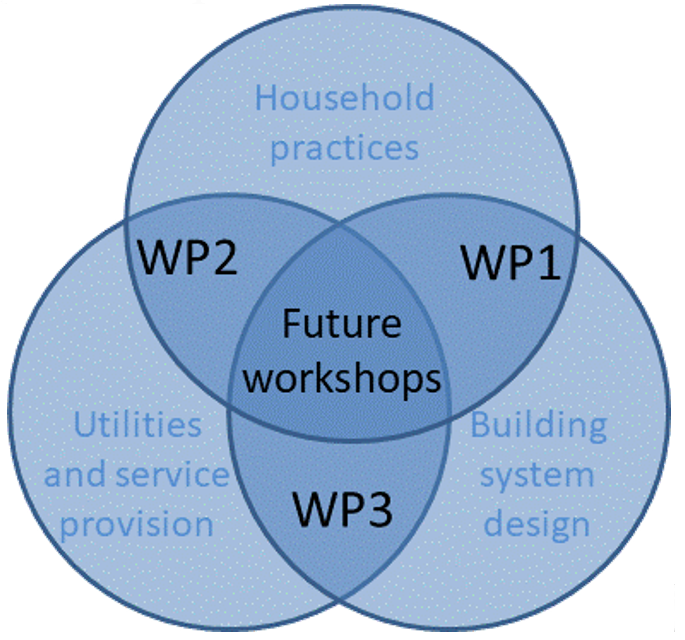Work packages: structure and content
InterHUB is organized into three different work packages, each dealing with a specific aspect of the overall vision of actively integrating buildings into the future energy system, facilitating energy savings and an increased use of intermittent energy. The overarching research aim is to analyze the changing roles and challenges that arise from this at the intersection between building systems design; household practices, and energy provision as shown in figure 2. Each WP will involve interdisciplinary collaboration on specific research questions pertaining to each of these three intersections.

Figure: Location of the three WPs, as well as the future workshops, at the intersections between the three dimensions identified as those relevant for the integration of buildings into the energy system.
Work package 1: Buildings and Households
Research in this WP will focus on the relation between the household and the building systems design and how this interaction takes place depending on the type of technologies and buildings used in new smart grid settings. Focus will include understanding how new routines and practices related to buildings and technologies are developed and how these influence householders’ understanding of comfort. The study will localize new and existing buildings with different types of control systems related to heating and cooling and will investigate how indoor climate control is perceived by householders, and how this varies with different types of heating systems and different types of housing. The study will also investigate the implications of control being performed by households, utilities or other actors. The study will include qualitative interviews with householders as well as data from the integrative future workshops, especially with regard to improving technology developers’ understandings of household practices. The work will also focus on the development of a new design and evaluation framework including appropriate modelling methods, that allow for the optimal design and operation of energy flexible buildings – both existing and future buildings and building energy systems – while taking into account the impact and consequences for user practices and user acceptability of different design solutions identified in this WP.
Work package 2: Households and Utilities
WP 2 will focus on what impact the changing relations between households and the energy supply system may have in terms of social and environmental sustainability. Although new business models are expected to lead to energy services, attention should also be on what social consequences they may have. What types of households are capable of reacting to and benefitting from different business models, and will this produce new social inequality in terms of e.g. comfort and health? Taking the value dilemmas of utility companies as a point of departure, this WP will also address the question of value, and the ways in which energy provision and services are made valuable for households. The study will use results from the integrative future workshops to identify focus groups with householders as well as with actors from the utilities to discuss how new services can be made valuable for the householders. Furthermore, we will utilize the extensive and unique data possibilities that we have in DK, combining the Data-hub and its hourly electricity consumption for all households with socio-economic and building data. This data will be utilized to model how different business models and pricing structures will provide different situations for different types (social classes) of households. The same data will focus on households with heat pumps, with and without own PV production, to reveal people’s willingness to adjust heat consumption to production. Finally, this data possibility will also be related to an on-going development project deploying ideas of gamification to engage households to relate their consumption to different signals of production. Results can reveal new knowledge on what type of consumers are more likely to be interested and capable of responding to this type of communication.
Work package 3: Buildings and Utilities
The introduction of buildings into the energy system changes ‘the system’ boundaries, and this will affect both the energy system and the ways in which building systems are designed. It is important to study both aspects and the relation between them. Hence, the overarching aim is to investigate the implications that integrating buildings into the energy infrastructure of heating and cooling can have for building design and evaluation framework. One study in WP3 will extend the developed design and evaluation framework from WP1 to include optimal building design solutions and operational strategies in providing the best flexibility services for the energy system depending on different possible approaches to utility/building interaction and on different developed business models for provision of energy flexibility. The work will include analysis of the sensitivity of optimal building design and operation to different flexibility needs of energy grids, different business models for provision of energy flexibility. WP 3 will also draw on literature studies, interviews and results from the integrative future workshops to analyze how integrating buildings into the energy system challenges the utilities’ existing modes of operation, business models, and investment decisions. Special attention will be given to points of contention as these will provide important insights to how existing roles and responsibilities can be changed. The purpose is to identify new, emergent modes of operation/BM, and go into depth on how they are being developed. This will entail in-depth, interview-based studies with the aim of clarifying how utilities, e.g. district heating, in such instances create and appropriate value. The study will also investigate what influence heating system configuration has on the flexibility services being provided by buildings.
